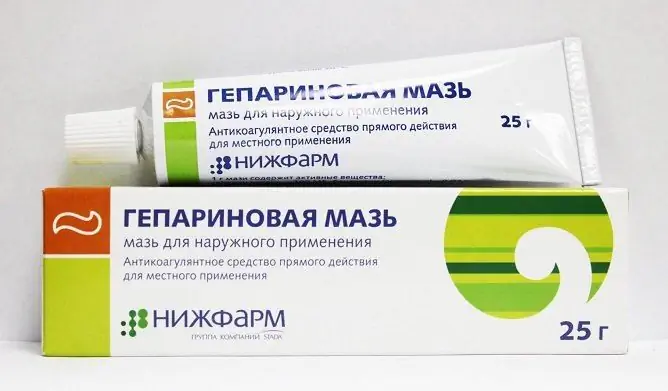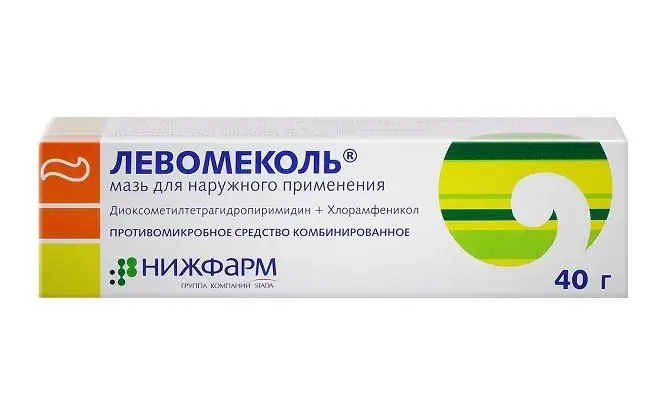- Author Rachel Wainwright [email protected].
- Public 2023-12-15 07:39.
- Last modified 2025-11-02 20:14.
Betasalik
Betasalik: instructions for use and reviews
- 1. Release form and composition
- 2. Pharmacological properties
- 3. Indications for use
- 4. Contraindications
- 5. Method of application and dosage
- 6. Side effects
- 7. Overdose
- 8. Special instructions
- 9. Application during pregnancy and lactation
- 10. Use in childhood
- 11. Drug interactions
- 12. Analogs
- 13. Terms and conditions of storage
- 14. Terms of dispensing from pharmacies
- 15. Reviews
- 16. Price in pharmacies
Latin name: Betasalic
ATX code: D07XC01
Active ingredient: salicylic acid (Salicylic Acid) + betamethasone (Betamethasonum)
Manufacturer: Kievmedpreparat OJSC (Ukraine)
Description and photo updated: 2019-27-08

Betasalik belongs to a number of glucocorticosteroid drugs (a subclass of adrenal cortex hormones, which has a strong effect on carbohydrate metabolism) of local action.
Release form and composition
The drug is produced in the form of a homogeneous ointment (15 g in tubes, in a cardboard box 1 tube and instructions for use of Betasalik).
100 g of the preparation contains:
- Salicylic acid - 3 g;
- Betamethasone dipropionate - 0.064 g.
Additional substances: vaseline, medical vaseline oil.
Pharmacological properties
Pharmacodynamics
Betasalik is a combined preparation with antiseptic, anti-inflammatory, antiallergic, antiproliferative and keratolytic action, which is due to the properties of its active components.
Salicylic acid has a pronounced keratolytic and exfoliating effect, due to which it removes horny deposits and softens the skin. In addition, it provides better penetration of the second active substance Betasalica into the depths of the skin. It normalizes the physiological acidity of the skin, prevents the formation of microbial and fungal infections.
Betamethasone dipropionate is a glucocorticosteroid that has anti-inflammatory, antipruritic, antiexudative, anti-edema and anti-allergic effects. Interferes with the release of inflammatory mediators and lysosomal enzymes. Reduces the severity of the local inflammatory response. Slows down the rate of accumulation of leukocytes. Reduces vascular tissue permeability, prevents the development of inflammatory edema, inhibits the course of phagocytosis.
Pharmacokinetics
Betamethasone easily penetrates through the stratum corneum deep into the skin. Does not penetrate into the systemic circulation, does not undergo biotransformation. However, with prolonged treatment, in the case of applying the ointment to damaged or delicate areas of the body, as well as in the presence of a concomitant inflammatory process, the substance may be partially absorbed. In this case, it is metabolized in the hepatobiliary system.
It is excreted unchanged in the bile. In small amounts, it can be excreted as a compound with glucuronic acid.
Indications for use
- Psoriasis;
- Neurodermatitis;
- Eczema in acute and chronic form;
- Lichen planus;
- Seborrheic dermatitis;
- Dyshidrosis;
- Ichthyosis and ichthyosis lesions;
- Seborrhea of the scalp;
- Chronic atopic dermatitis.
Contraindications
Betasalik ointment is contraindicated for skin manifestations of the following diseases:
- Tuberculosis;
- Primary viral infections;
- Fungal lesions;
- Syphilis.
Also, you should not use this hormonal ointment in the presence of acne (including pink), skin reactions after vaccinations, hypersensitivity to the components of the drug.
Betasalik, instructions for use: method and dosage
Betasalik is allowed to be applied only topically locally. The ointment is applied to the affected area with a thin layer, gently rubbing into the skin, 2 times a day. For some diseases, as in the case of maintenance therapy, it is enough to apply the drug once a day.
The course of treatment is discontinued after the disappearance of symptoms: removal of inflammation, cessation of itching, cleansing of the skin. It should be borne in mind that the duration of Betasalik ointment application should not exceed 10 days.
It is allowed to use the ointment for children over the age of 2 years, the duration of therapy should be limited to 5 days.
Side effects
The use of Betasalik can cause side effects such as: itching, burning and dryness of the skin, folliculitis, hypertrichosis, acne, hypopigmentation, perioral and allergic contact dermatitis.
Side effects when using the ointment with occlusive dressings: maceration, prickly heat, skin atrophy, striae, accession of a secondary infection.
Stretch marks and vasodilation (mainly on the face) are mainly the result of prolonged continuous application of the ointment.
Overdose
With external application of the ointment in compliance with the recommendations, acute intoxication is excluded.
Overdose of each of the active components of Betasalic, possible in case of excessive or prolonged use:
- Betamethasone dipropionate (topical corticosteroid): can cause suppression of the function of the pituitary-adrenal system, with the subsequent development of secondary adrenal insufficiency and the appearance of symptoms of hypercortisolism, including Cushing's disease. In such conditions, appropriate symptomatic therapy is recommended. Acute manifestations of hypercortisolism are usually reversible. If necessary, the electrolyte balance is corrected. With chronic toxic effects, the corticosteroid is gradually withdrawn;
- Salicylic acid: Topical preparations containing salicylic acid can cause symptoms of salicylism. It is recommended to carry out symptomatic therapy, including a set of measures for the faster removal of salicylates from the body; oral administration of sodium bicarbonate to alkalinize urine and increase urine output.
special instructions
Betasalik is not used in ophthalmic practice. Avoid getting the ointment in the eyes.
Due to the presence of salicylic acid, the ointment should not be applied to damaged skin.
In case of skin irritation, including excessive dryness, or manifestation of hypersensitivity reactions during the use of the drug, treatment should be discontinued.
It is necessary to avoid getting the ointment on wound surfaces, mucous membranes and ulcers; Betasalik should not be applied to areas with atrophied skin.
After the passage of dandruff or cornification, therapy is continued with drugs containing only corticosteroids.
If signs of infection are observed, appropriate treatment is required.
Side effects resulting from the systemic use of corticosteroids (including suppression of the function of the adrenal cortex) can also be observed in the case of excessive prolonged local use, especially in pediatrics. Systemic absorption of corticosteroids and salicylates when used topically is increased during therapy of large areas of the skin, as well as when ointment is applied under occlusive dressings.
The duration of the therapeutic course, if it is necessary to use the ointment on the skin of the face or for the treatment of children, should not exceed 5 days.
Long-term use of Betasalik should be avoided by all patients, regardless of age.
It should be borne in mind that the external use of corticosteroids for a number of reasons can cause psoriasis, including the resumption of its symptoms with the development of further tolerance to therapy, the risk of pustular psoriasis, as well as the manifestation of local systemic toxicity as a result of a decrease in the protective function of the skin.
In case of impaired liver function, the sensitivity to the systemic effect of the drug increases.
The use of topical corticosteroids can distort the clinical picture.
In case of interruption of treatment, a relapse of the disease, an exacerbation of the infection, and a delay in healing are possible.
Influence on the ability to drive vehicles and complex mechanisms
The effect of Betasalik therapy on the speed of patients' psychomotor reactions and the ability to concentrate has not been studied.
Application during pregnancy and lactation
The experience of clinical use of Betasalik during pregnancy is not enough to assess the degree of its safety, therefore, the drug can be used only as directed by a doctor for the treatment of small-area skin lesions.
If therapy is required during lactation, breastfeeding is recommended to be discontinued.
Pediatric use
Betasalik ointment is used to treat children over two years old, with the minimum possible therapeutic course
In childhood, manifestations of external corticosteroid effects and signs of inhibition of the hypothalamic-pituitary-adrenal system under the influence of local corticosteroids occur more often than in adult patients. This is due to the increased absorption of the drug due to the larger value of the coefficient characterizing the ratio of the skin surface area to the child's body weight.
With topical corticosteroid therapy in children, depression of the hypothalamic-pituitary-adrenal system, Cushing's syndrome, linear growth retardation, insufficient body weight gain, and increased intracranial pressure are possible. Adrenal suppression in childhood is characterized by a low level of cortisol in the blood plasma and a lack of response to stimulation of adrenocorticotropic hormone (ACTH). Symptoms of increased intracranial pressure are protrusion of the fontanelle, headache, bilateral edema of the optic discs.
Betasalik ointment should not be applied under diapers.
Drug interactions
With the simultaneous use of Betasalik with resorcinol or tretinoin, irritation and dryness of the skin may increase.
There are no reports of other clinically significant drug interactions.
Analogs
The analogues of Betasalik are Belosalik, Betasalik KMP, Diprosalik, Dexocort, Dermokas, Triderm, Soderm, Triacutan, Deoxycorticosterone trimethylacetate, Flixotide, etc.
Terms and conditions of storage
Store in a dry, protected from direct sunlight. Temperature range from 8 to 15 ° C.
Shelf life is 2 years.
Terms of dispensing from pharmacies
Available without a prescription.
Reviews about Betasalik
Both doctors and the patients themselves leave mostly positive reviews about Betasalik: the drug effectively eliminates inflammation, itching, redness and flaking of the skin, helps to eliminate psoriatic plaques and rashes with dermatitis, is well tolerated, does not cause addiction.
The negative messages describe individual reactions of intolerance and the possibility of a relapse of the disease after discontinuation of the drug.
The price of Betasalik in pharmacies
At the moment, the drug is not available for sale, so the price of Betasalik is unknown.
The cost of its popular analogue Belosalik is 190-278 rubles. for a tube containing 15 g of ointment for external use.

Maria Kulkes Medical journalist About the author
Education: First Moscow State Medical University named after I. M. Sechenov, specialty "General Medicine".
Information about the drug is generalized, provided for informational purposes only and does not replace the official instructions. Self-medication is hazardous to health!






